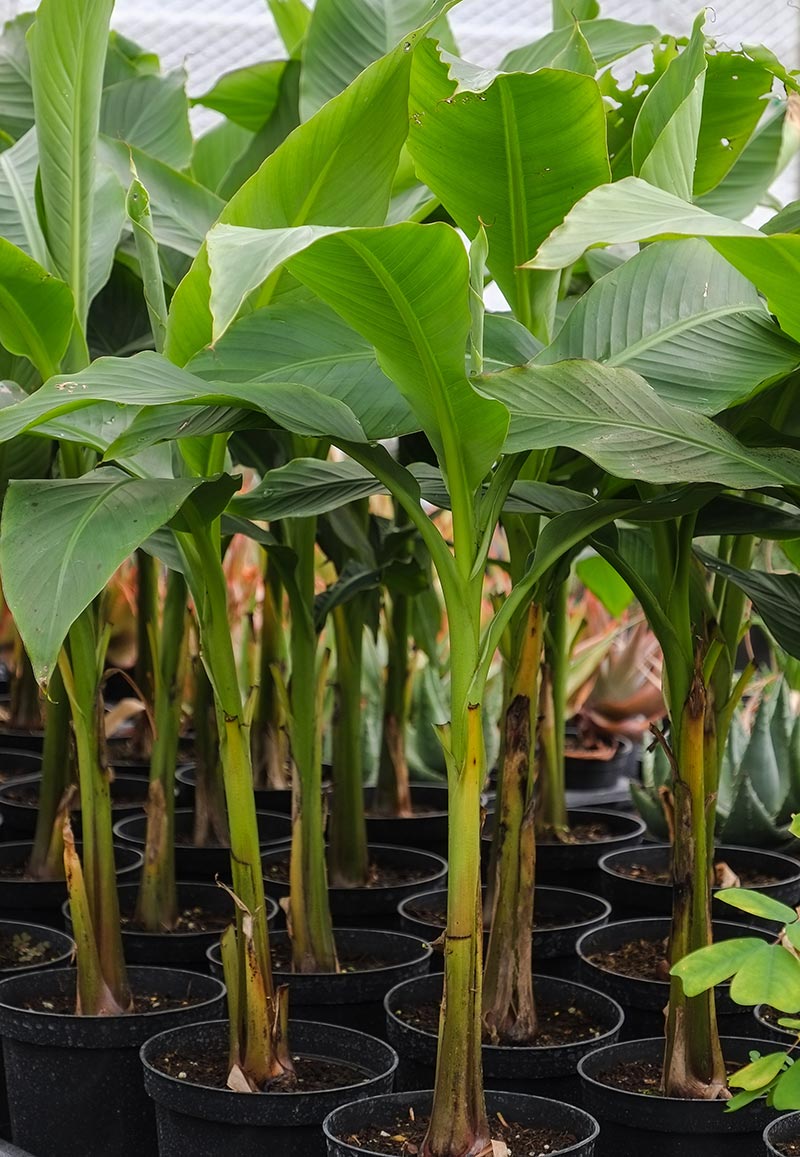
How To Grow Banana Trees In Pots
Growing Banana trees in pots is easy, if you’re unable to grow it on the ground either due to lack of space or cold climate. Learn how to grow banana trees in this complete article.
There are banana varieties that can withstand temperature drops and grows well in containers, popular especially among the fans of exotic tropical plants in the garden. The first question that may come up in your mind is– Will banana tree in a pot can bear fruits? And the answer is yes. It is possible, a banana tree bears fruits in pot prolifically. It may take up to 3 to 5 years to fruit if grown from seeds.
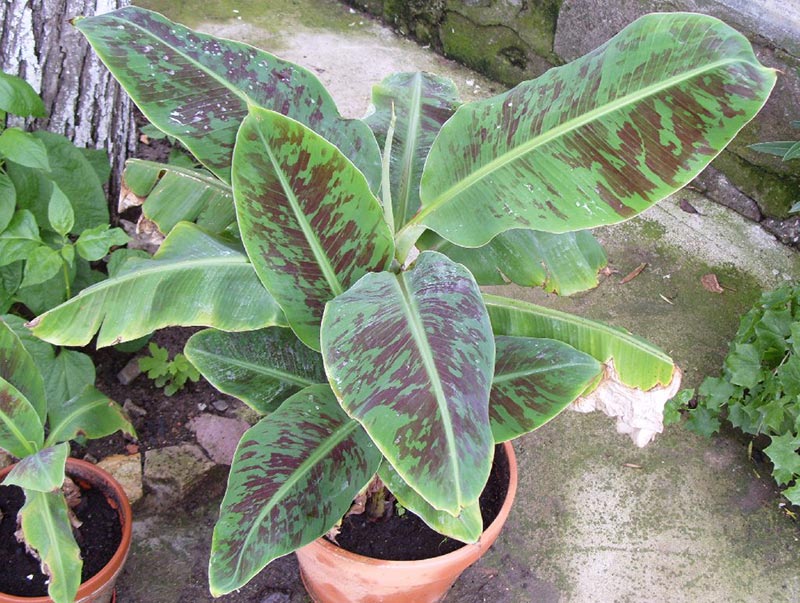
Growing Banana Trees in Pots
Banana is a lush green, fast-growing plant that can give any place a tropical look and feel. Many varieties become excellent houseplants that don’t need much care and grow up very quickly.
Dwarf varieties of banana trees can grow anywhere between 2 to 4 meters. Compared to the ordinary banana trees that can reach up to 15 meters high.
Growing Banana Trees in Pots in Tropics
Growing banana tree in pot in a tropical climate is extremely easy, with little to no care banana tree grows in the container. If you’re living under USDA Zones 9 to 11, keep your banana tree in the shade in afternoon in summer, when the plant is young. All the other requirements are similar as given below in the article for temperate zones.

Banana Varieties you can Grow in Pots and Indoors
These dwarf varieties of banana tree restrict up to only 1.5 m to 4 m. (4 to 12 feet) tall and are suitable to grow in containers. You can also grow these banana varieties indoors.
- Dwarf Red
- Dwarf Cavendish
- Dwarf Brazilian
- Dwarf Jamaican
- Rajapuri
- Williams Hybrid
- Gran Nain
- Dwarf ‘Lady Finger’
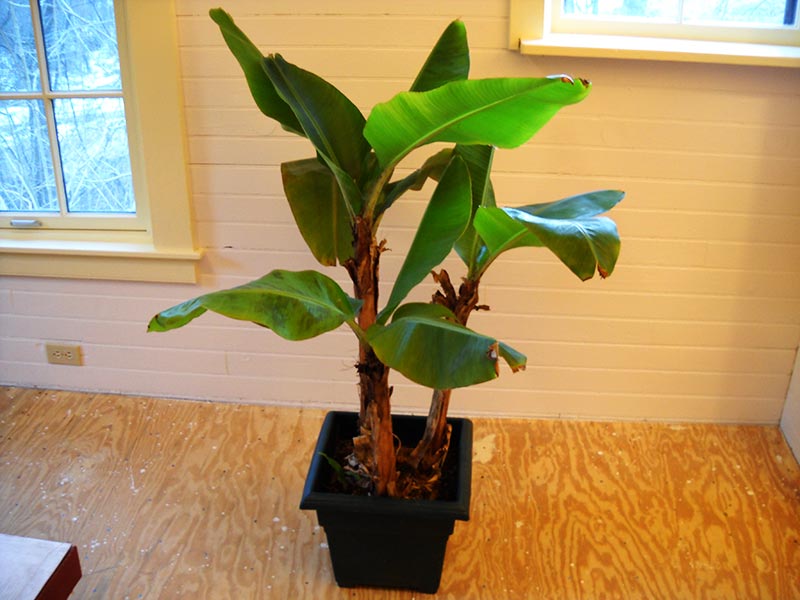
If you would like to grow ornamental bananas check out these varieties:
- Ensete ventricosum
- Musa sikkimensis ‘Red Tiger’
- Musa ornata
Requirements for Growing Banana Trees in Pots
Sun
Banana trees grow in tropical and subtropical parts of the world and therefore they love full sun, heat and humidity. If you’re growing banana tree you should keep it in a spot that receives the sun most of the day but preferably sheltered from the wind.
Soil
Growing Banana tree requires well-draining soil, sandy soil that is rich in organic matters and compost. Buy a good quality potting mix for your banana tree. If you are making it at home make sure to mix sand, perlite, and compost or manure.
Banana needs slightly acidic to neutral soil to produce those potassium rich nutritious bananas. The soil pH should be around 6 – 7. If your soil is alkaline mix sulfur to decrease the pH.
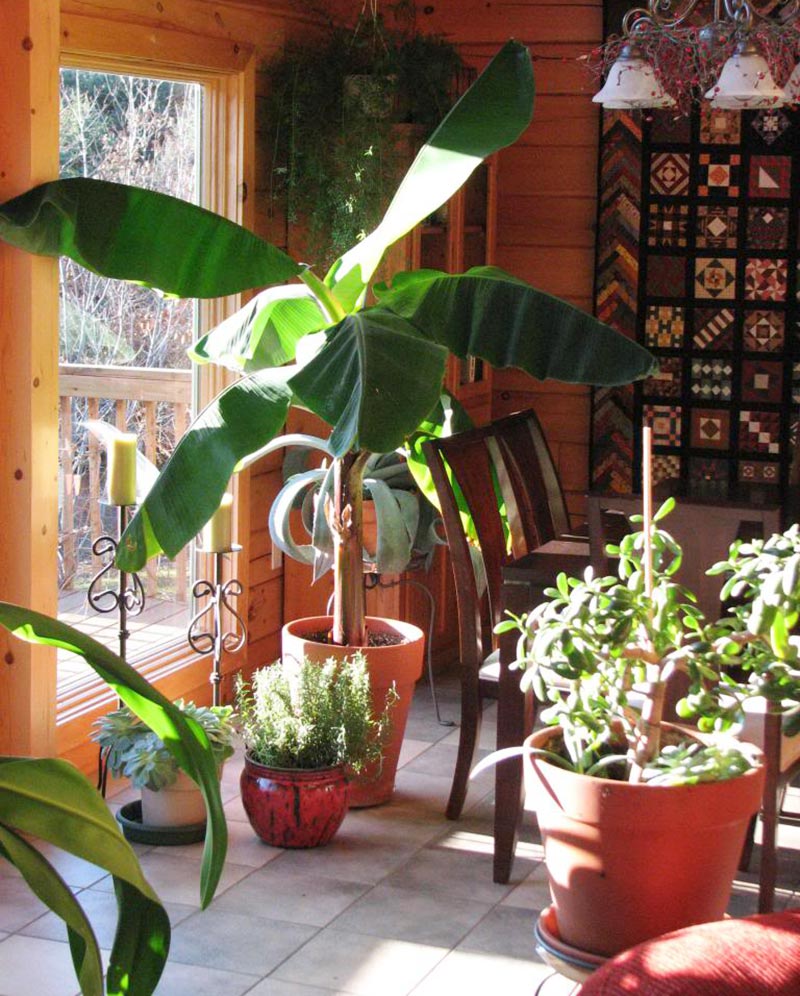
Watering
Banana loves moisture. Water it regularly and deeply but care not to overwater. In summer, water it every day. It may need water even two times a day in hot weather or when it is root bound. Soil for growing banana plants should be kept uniformly moist. Reduce watering in winter.
How to Plant?
Commercially grown bananas that are cultivated specifically for consumption don’t have seeds. Over time, they have been modified to have three sets of genes instead of two (triploid) and produce no seeds. In nature, however, one encounters many banana types with seeds; in fact, some seeds are so large it is difficult to get to the pulp. The banana you are eating for breakfast has been genetically tinkered with to lack seeds and are usually Cavendish bananas. There are many other banana varieties out there and they do contain seeds.
Cavendish bananas are propagated by pups or suckers, pieces of rhizome that form into miniature banana plants that can be severed from the parent and planted to become a separate plant. In the wild, bananas are propagated via seed. You, too, can grow seed grown bananas.
If you want to grow seed grown bananas, be aware that the resulting fruit will not be like those you buy at the grocers. They will contain seeds and, depending upon the variety, might be so large that the fruit is difficult to get to.
Growing from Seed
To begin germinating the banana seeds, soak the seed in warm water for 24 to 48 hours to break the seed dormancy. This softens the seed coat, enabling the embryo to sprout more easily and rapidly.
Use a seed tray or other container and fill with potting soil enriched with plenty of organic compost in the amount of 60% sand or airy, loam to 40% organic matter. Sow the banana seeds 1/4 inch deep and backfill with compost. Water the seeds until the soil is moist, not drenched, and maintain damp conditions while growing banana trees from seeds.
When germinating banana seeds, even hardy bananas, keep the temperature at least 60 degrees F. (15 C.). Different varieties respond to temperature fluxes differently, however. Some do well with 19 hours of cool and 5 hours of warm temps. Using a heated propagator and turning it on during the day and off at night may be the easiest way to monitor temperature fluctuations. The time that a banana seed germinates, again, depends on the variety. Some germinate in 2-3 weeks while others may take two or more months, so be patient when propagating banana plants via seed.
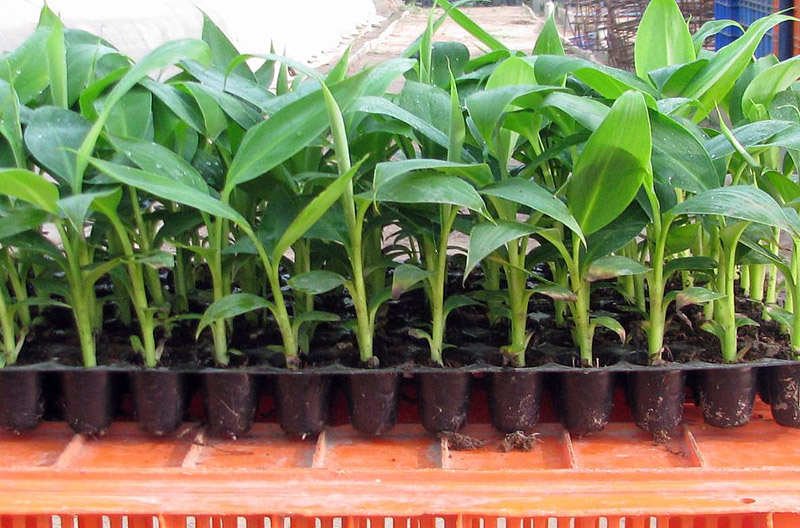
As each seed germinates, lift carefully from the tray so as to prevent any damage to the juvenile root system, and transfer it to a 3 in pot of good quality, free draining compost.
Banana Suckers
Every banana plant begins as an underground bulb from which the true stem grows. The stem develops through the center of the stalk, which than later produces fruit.
Each stalk supplies massive flower cluster which whiter away. In its place another stalk grows. The process keeps repeating itself until the tree produces fruit, typically after one year of cultivating new plant. To accelerate the process, fertilizers rich in potassium are recommended.
The suckers (pups) that grow at the base of the plant can be removed to propagate more new plants. After the plants have matured and produced fruit, it is important to leave at least one sucker in place as the mother plant will die if all the suckers are removed prematurely.
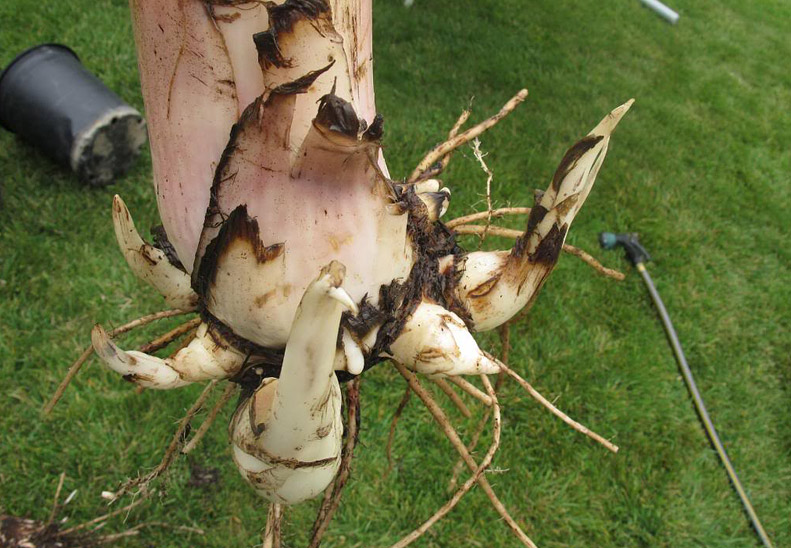
Banana Corm
Most banana plants come as bulbs or corms, but very few nurseries keep them in stack. They can be special ordered or they can be purchased from different vendors via online. When the shipment arrives, washing them in lukewarm water will ensure that any fungal deposits, debris and bacteria will be removed before planting. It will ensure proper potting and establishing the plant into its maturity.
The beginning stages of the banana plant should start in a medium-sized standard container with a drainage hole at the bottom to prevent standing water and assure proper ventilation for the developing roots. Once the corm is planted, it will need a combination of bright light, warmth and high humidity to start sprouting leaves.
Plant the rhizome upright leaving the top part uncovered to allow the light exposure. When several new leaves appear, the corm can be completely covered with soil to promote better stability and additional root growth. Replanting to a bigger pot will become necessary when the plant becomes container bound or it will stop bearing fruit.
Banana Plant in Pot Care
Humidity
Banana plant prefers humidity levels above 50%. To increase humidity level around the plant, mist the plant and place it on a layer of pebbles in a tray filled with water.
Overwintering Banana Tree
Banana plants stop growing when the temperature drops below 50 ° Fahrenheit. Before the onset of winter, do heavy mulching and prune the leaves. Put it in a warm, bright room till the spring.

Fertilizer
Banana is a fast growing plant and it requires heavy feeding to grow at its full strength. Fertilize young plant when it establishes well with nitrogen-rich fertilizer to help it grow faster. Once your banana tree in pot becomes mature enough to produce fruit, fertilize it with 15:5:30 fertilizer regularly.
Pests and diseases
Bananas are quite resistant to diseases, still when you see the leaves turning brown and drying at the edges it means you’re overwatering and if the leaves turn yellow, banana plant is having a lack of nutrients.
Some pests that might attack banana plant are banana aphids, banana weevil, and coconut scale. These pests can easily be repelled using organic pesticides.
Related: How To Grow Citrus in Containers
Please follow us on Facebook Page and enjoy our collection of recipes, crafts, fitness, health tips, gardening, DIY and more…
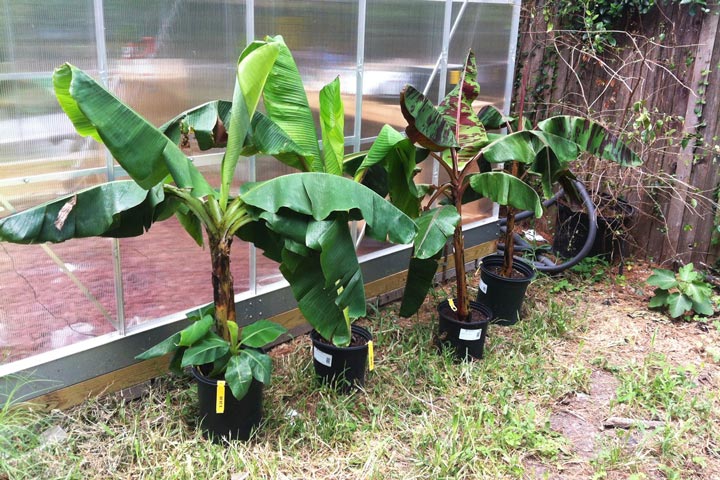
Source sketchysloth.com

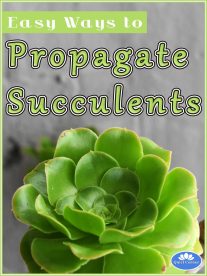
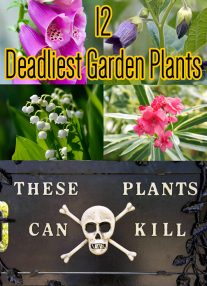
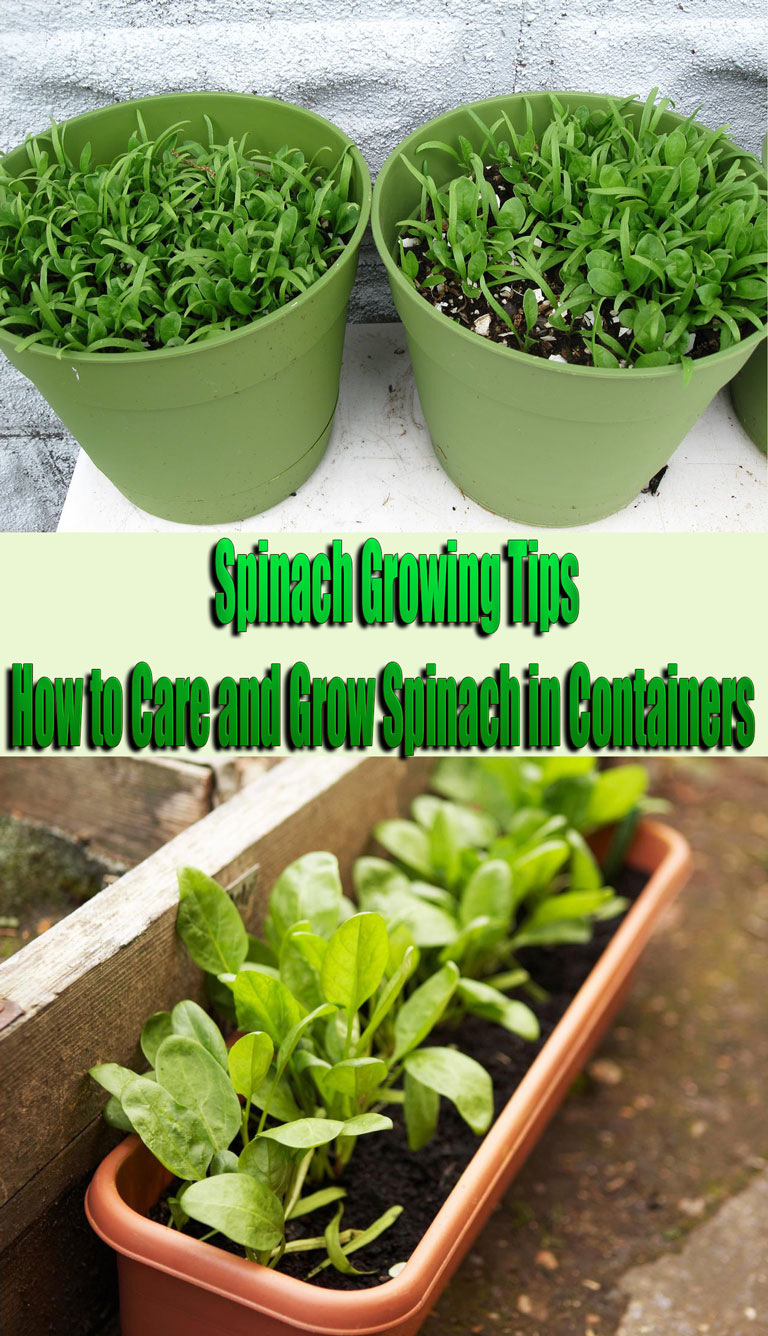
I started to listened to your video. While information is probably good the speaker’s choice of vocabulary is disgusting and crude.
This is a homemade video and not a professional one. Perhaps you need to watch only commercialized videos. I thought the man was sincere and excited to show what he had learned. Sometimes it is best to say nothing if you cannot say anything good about something.
Hooray for you… you are right. There was nothing wrong with this video. There are a lot of different accents
In this world, and that was his…give us a break….
And the video was very informative!!!
Be nice! If you can’t say anything nice, then don’t say anything at all !!! He is doing everyone a kindness and as a public service for all of our benefit! If anyone is “crude”, it is YOU!! Look at yourself in the mirror. He is a southerner, and he is speaking his vernacular for his area of the country. I am well educated and I would be proud to call him “FRIEND”!
I think he did a great job. You should of stopped commenting after the word GOOD.
We enjoyed the speakers information but not his language. We turned it off as soon as he started using bad vocabulary. I agree with Kejsey.
Oh no. Not everyone on the planet speaks perfect English. Not speaking perfect English isn’t “disgusting”. Being a racist bitch however is “disgusting”. And that is your English lesson of the day. Seem’s your grasp of the language is lacking as well. Result of inferior breeding stock I imagine on your part. Parent’s were first cousin’s perhaps? Grandpa and dad are the same man maybe? I’m just judging you on your trailer park level grasp of vocabulary , nothing personal really. Interesting banana info , I found it somewhat informative.
Great job can’t wait to start mine. I am always growing plants or tree’s from seed . And I love your southern language that is what kept me to your video.you rock
I thought the video was very helpful and down to earth and fun so.e people have a very dry sense of personality and no humor
No…….. your choice of vocabulary is beatchy….. remember you started at first
I’m sure he cares about your critique of his vocabulary. Since that is obviously what is the most important, making sure that Kejsy isn’t offended by how someone talks.
This was a fun and informative video. I don’t understand Yolanda Vega’s comment at all. Very off base. She talks like something inappropriate was said in the video. Not in the least! I really had no idea that those tiny specks in the bananas we buy in the store were not actually the seeds. I would love to grow a banana tree. Thanks for a great video!
Yolanda, Its people like you who keep future generations behind. Evolve a bit why don’t you? What are you a princess?
I honestly dont see the big deal/ problem with the way he is speaking haha my whole family talks worse then that ( although they consider themselves “rednecks” 😂And we live out in the country) but maybe we should not get so angry at Yolanda? Everyone is different and thats prefectly fine. Maybe where she is from cussing isnt common and is frowned upon or perhaps she is just more sensitve and doesnt feel comfertable around southern slang. Anyway my point is, you cant fight fire with fire so just be the rain and put the fire out, people. Just because one person doesnt like the video doesnt mean we all have to not enjoy it too. I feel the video was funny and helpful but like i said before ” everyone is different” and thats ok 🙂 Just do what makes you happy!
I happen to have lived n so many different communities in different countries. Local dialects are strange but we MUST tolerate them because that is what the world is made of and will always be so.
Love Jacob
I am from South Africa and love to get some information about plants all over. The information given in this video is of high value given you know nothing about banana seeds. It is a pity though our plant stores do not sell the seeds you can only buy the plants if in the correct region. Thank you for the video.
So many more important things to worry about Yolanda, like people working evil on others all the while using great language.
Anyway- dude. They’re probably an unstory plant so they thrive in filtered light. Put them in bright light and they’ll be burned.
(At least 20% give up on captcha; this looks like a higher than average failure rate)
Hi, great video!
One question: Before ending up the same way (trying to get the tiny seeds grow): Where did you buy your seeds?
Best wishes,
Britta
Britta, check out https://www.seedman.com/banana.htm there you can find banana seeds for sale.
An excellent video and write up, I often wondered how to grow Bananas and did not know about the ones we eat.
Question:
You grow your Bananas from seed – On fruiting do the bananas have the same seed and less ‘Meat’ in them or similar to the commercial type.
I liked this video… Did a good job with navigating the cam himself… I didn’t know banana seeds was that big… You can also take the keiki banana shoots and plant those… thats how we do it:)
where can i get the seeds from or do i dry a banana
It sounds very good but I dont know where to get a banana seed from. can you buy dried banana.
I live in England, can I grow one here and where could I get the seeds, your video wa brilliant
Where can I get seeds. Live in southern indiana
Excellent video. I think the accent is sexy. Very informative too. Got me excited about trying my hand at a banana tree.
While living in Florida, I used to occasionally find a banana tree with bananas turning ripe. If they were picked when they first turned yellow they were delicious. If still green they tasted like plantains and would not ripen. We called them horse bananas. About 4-5″ long. Can’t find them ripe anymore . Too many people. Won’t leave them alone till they ripen.